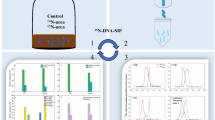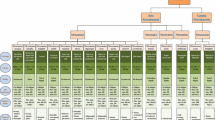Abstract
In this study, sludge was taken from a municipal wastewater treatment plant that contained a nearly equal number of archaeal amoA genes (5.70 × 106 ± 3.30 × 105 copies mg sludge−1) to bacterial amoA genes (8.60 × 106 ± 7.64 × 105 copies mg sludge−1) and enriched in three continuous-flow reactors receiving an inorganic medium containing different ammonium concentrations: 2, 10, and 30 mM NH +4 –N (28, 140, and 420 mg N l−1). The abundance and communities of ammonia-oxidizing archaea (AOA) and ammonia-oxidizing bacteria (AOB) in enriched nitrifying activated sludge (NAS) were monitored at days 60 and 360 of the operation. Early on, between day 0 and day 60 of reactor operation, comparative abundance of AOA amoA genes to AOB amoA genes varied among the reactors depending on the ammonium levels found in the reactors. As compared to the seed sludge, the number of AOA amoA genes was unchanged in the reactor with lower ammonium level (0.06 ± 0.04 mgN l−1), while in the reactors with higher ammonium levels (0.51 ± 0.33 and 0.25 ± 0.10 mgN l−1), the numbers of AOA amoA genes were deteriorated. By day 360, AOA disappeared from the ammonia-oxidizing consortiums in all reactors. The majority of the AOA sequences from all NASs at each sampling period fell into a single AOA cluster, however, suggesting that the ammonium did not affect the AOA communities under this operational condition. This result is contradictory to the case of AOB, where the communities varied significantly among the NASs. AOB with a high affinity for ammonia were present in the reactors with lower ammonium levels, whereas AOB with a low affinity to ammonia existed in the reactors with higher ammonium levels.




Similar content being viewed by others
References
Aakra A, Utaker JB, Nes IF (1999) RFLP of rRNA genes and sequencing of the 16S-23S rDNA intergenic spacer region of ammonia-oxidizing bacteria: a phylogenetic approach. Int J Sys Bacteriol 49:123–130
Belser LW, Schmidt EL (1980) Growth and oxidation kinetics of three genera of ammonia oxidizing nitrifiers. FEMS Microbiol Lett 7:213–216
Caffrey JM, Bano N, Kalanetra K, Hollibaugh JT (2007) Ammonia oxidation and ammonia-oxidizing bacteria and archaea from estuaries with differing histories of hypoxia. ISME J 1:660–662
Clesceri LS, Greenberg AE, Eaton AD (1998) Standard methods for the examination of water and wastewater, 20th edn. APHA, AWWA and WEF, USA
De La Torre JR, Walker CB, Ingalls AE, Konneke M, Stahl DA (2008) Cultivation of a thermophilic ammonia oxidizing archaeon synthesizing crenarchaeol. Environ Microbiol 10:810–818
Dionisi HM, Layton AC, Harms G, Gregory IR, Robinson KG, Sayler GS (2002) Quantification of Nitrosomonas oligotropha like ammonia-oxidizing bacteria and Nitrospira spp. from full-scale wastewater treatment plants by competitive PCR. Appl Environ Microbiol 68:245–253
Erguder TH, Boon BN, Wittebolle L, Marzorati M, Verstraete W (2009) Environmental factors shaping the ecological niches ofammoniaoxidizing archaea. FEMS Microbiol Rev 33:855–869
Francis CA, Roberts KJ, Beman JM, Santoro AE, Oakley BB (2005) Ubiquity and diversity of ammonia-oxidizing archaea in water columns and sediments of the ocean. Proc Natl Acad Sci USA 102:14683–14688
Geets J, de Cooman M, Wittebolle L, Heylen K, Vanparys B, De Vos P, Verstraete W, Boon N (2007) Real-time PCR assay for the simultaneous quantification of nitrifying and denitrifying bacteria in activated sludge. Appl Microbiol Biotechnol 75:211–221
Grommen R, Dauw L, Verstraete W (2005) Elevated salinity selects for a less diverse ammonia-oxidizing population in aquarium biofilters. FEMS Microbiol Ecol 52:1–11
Hatzenpichler R, Lebedeva EV, Spieck E, Stoecker K, Richter A, Daims H, Wagner M (2008) A moderately thermophilic ammonia-oxidizing crenarchaeote from a hot spring. Proc Natl Acad Sci USA 105:2134–2139
Juretschko S, Timmermann G, Schmid M, Schleifer KH, Pommerening-Roser A, Koops HP, Wagner M (1998) Combined molecular and conventional analyses of nitrifying bacterium diversity in activated sludge: Nitrosococcus mobilis and Nitrospira-like bacteria as dominant populations. Appl Environ Microbiol 64:3042–3051
Keen GA, Prosser JI (1987) Steady state and transient growth of autotrophic nitrifying bacteria. Arch Microbiol 147:73–79
Konneke M, Bernhard AE, De La Torre JR, Walker CB, Waterbury JB, Stahl DA (2005) Isolation of an autotrophic ammonia-oxidizing marine archaeon. Nature 437:543–546
Koops HP, Purkhold U, Pommerening-Roser A, Timmermann G, Wagner M (2003) The lithoautotrophic ammonia-oxidizing bacteria. In: Dworkin M (ed) The prokaryotes: an evoluting electronic resource for the microbiological community. Springer, New York
Kowalchuck GA, Stephen JR, De Boer W, Prosser JI, Embley TM, Woldendorp JM (1997) Analysis of ammonia-oxidizing bacteria of the b subdivision of the class Proteobacteria in costal sand dunes by denaturing gradient gel electrophoresis and sequencing of PCR-amplified 16S ribosomal DNA fragments. Appl Environ Microbiol 63:1489–1497
Laanbroek HJ, Bodelier PLE, Gerards S (1994) Oxygen consumption kinetics of Nitrosomonas europaea and Nitrobacter hamburgensis grown in mixed continuous cultures at different oxygen concentrations. Arch Microbiol 161:156–162
Leininger S, Urich T, Schloter M, Schwark L, Qi J, Nicol GW (2006) Archaea predominate among ammonia-oxidizing prokaryotes in soils. Nature 442:806–809
Limpiyakorn T, Shinihara Y, Kurisu F, Yagi O (2005) Communities of ammonia-oxidizing bacteria in activated sludge of various sewage treatment plants in Tokyo. FEMS Microbiol Ecol 54:205–117
Limpiyakorn T, Kurisu F, Yagi O (2006a) Development and application of real-time PCR quantification for particular ammonia-oxidizing bacteria in full-scale sewage activated sludge systems and continuous enrichment cultures. Appl Microbiol Biol 72:1004–1013
Limpiyakorn T, Kurisu F, Yagi O (2006b) Quantification of ammonia-oxidizing bacteria populations in full-scale sewage activated sludge systems and assessment of system variables affecting their performance. Water Sci Technol 54:91–99
Limpiyakorn T, Kurisu F, Sakamoto Y, Yagi O (2007) Effects of ammonium and nitrite on communities and populations of ammonia-oxidizing bacteria in laboratory-scale continuous-flow reactors. FEMS Microbiol Ecol 60:501–512
Martens-Habbena W, Berube PM, Urakawal H, de la Torrel JR, Stahl DA (2009) Ammonia oxidation kinetics determine niche separation of nitrifying archaea and bacteria. Nature 461:976–981
Nakamura Y, Satoh H, Kindaichi T, Okabe S (2006) Community structure, abundance, and in situ activity of nitrifying bacteria in river sediments as determined by the combined use of molecular techniques and microelectrodes. Environ Sci Technol 40:1532–1539
Nicol GW, Schleper C (2006) Ammonia-oxidising Crenarchaeota: important players in the nitrogen cycle? Trends Microbiol 14:207–212
Norton JM, Alzerreca JJ, Suwa Y, Klotz MG (2002) Diversity of ammonia monooxygenase operon in autotrophic ammonia-oxidizing bacteria. Arch Microbiol 177:139–149
Park HD, Wells GF, Bae H, Criddle CS, Francis CA (2006) Occurrence of ammonia oxidizing archaea in wastewater treatment plant bioreactors. Appl Environ Microbiol 72:5643–5647
Pynaert K, Smets BF, Wyffels S, Beheydt D, Siciliano SD, Verstraete W (2003) Characterization of an autotrophic nitrogen-removing biofilm from a highly loaded lab-scale rotating biological contactor. Appl Environ Microbiol 69:3626–3635
Rotthauwe JH, Witzel KP, Liesack W (1997) The ammonia monooxygenase structural gene amoA as a functional marker: molecular fine-scale analysis of natural ammonia-oxidizing populations. Appl Environ Microbiol 63:4704–4712
Santoro AE, Francis CA, De Sieyes NR, Boehm AB (2008) Shifts in the relative abundance of ammonia-oxidizing bacteria and archaea across physicochemical gradients in a subterranean estuary. Environ Microbiol 10:1068–1079
Schloss PD, Handelsman J (2005) Introducing DOTUR, a computerprogram for defining operational taxonomic units and estimating species richness. Appl Environ Microbiol 71:1501–1506
Stehr G, Bottcher B, Dittberner P, Rath G, Koops HP (1995) The ammonia oxidizing nitrifying population of the River Elbe estuary. FEMS Microbiol Ecol 17:177–186
Treusch AH, Leininger S, Kletzin A, Schuster SC, Klenk HP, Schleper C (2005) Novel genes or nitrite reductase and Amo-related proteins indicate a role of uncultivated mesophilic crenarchaeota in nitrogen cycling. Environ Microbiol 7:1985–1995
Urakawa H, Tajima Y, Numata Y, Tsuneda S (2008) Low temperature decreases the phylogenetic diversity of ammonia-oxidizing archaea and bacteria in aquarium biofiltration systems. Appl Environ Microbiol 74:894–900
Venter JC, Remington K, Heidelberg JF, Halpern AL, Rusch D, Eisen JA, Wu D, Paulsen I, Nelson KE, Nelson W, Fouts DE, Levy S, Knap AH, Lomas MW, Nealson K, White O, Peterson J, Hoffman J, Parsons R, Baden-Tillson H, Pfannkoch C, Rogers Y-H, Smith HO (2004) Environmental genome shotgun sequencing of the Sargasso Sea. Science 304:66–74
Wuchter C, Abbas B, Coolen MJL, Herfort L, Van Bleijswijk J, Timmers P (2006) Archaeal nitrification in the ocean. Proc Natl Acad Sci USA 103:12317–12322
Acknowledgements
This work was supported by the 90th Anniversary of Chulalongkorn University Fund (Ratchadaphiseksomphot Endowment Fund) and the Thailand Research Fund under grant no. MRG5280086. Additionally, we would like to express our appreciation to the Bangkok Metropolitan Administration (BMA) for providing the seed sludge from one of its municipal WWTP. We also thank Professor Chongrak Polprasert for his guidance and Ms. Akiko Uyeda for her assistance in editing, polishing, and correcting the English language of our manuscript.
Author information
Authors and Affiliations
Corresponding author
Rights and permissions
About this article
Cite this article
Sonthiphand, P., Limpiyakorn, T. Change in ammonia-oxidizing microorganisms in enriched nitrifying activated sludge. Appl Microbiol Biotechnol 89, 843–853 (2011). https://doi.org/10.1007/s00253-010-2902-y
Received:
Revised:
Accepted:
Published:
Issue Date:
DOI: https://doi.org/10.1007/s00253-010-2902-y




